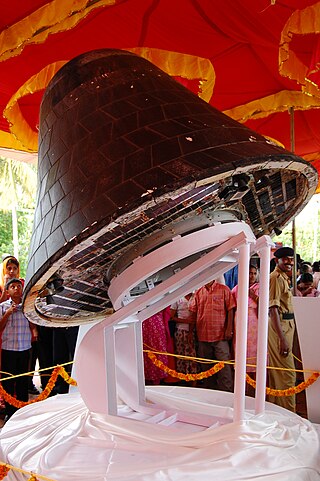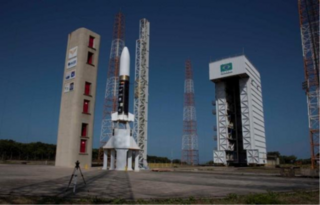
Atmospheric entry is the movement of an object from outer space into and through the gases of an atmosphere of a planet, dwarf planet, or natural satellite. There are two main types of atmospheric entry: uncontrolled entry, such as the entry of astronomical objects, space debris, or bolides; and controlled entry of a spacecraft capable of being navigated or following a predetermined course. Technologies and procedures allowing the controlled atmospheric entry, descent, and landing of spacecraft are collectively termed as EDL.

A waverider is a hypersonic aircraft design that improves its supersonic lift-to-drag ratio by using the shock waves being generated by its own flight as a lifting surface, a phenomenon known as compression lift.
In engineering, a heat shield is a component designed to protect an object or a human operator from being burnt or overheated by dissipating, reflecting, and/or absorbing heat. The term is most often used in reference to exhaust heat management and to systems for dissipating frictional heat. Heat shields are used most commonly in the automotive and aerospace industries.

A spaceplane is a vehicle that can fly and glide like an aircraft in Earth's atmosphere and maneuver like a spacecraft in outer space. To do so, spaceplanes must incorporate features of both aircraft and spacecraft. Orbital spaceplanes tend to be more similar to conventional spacecraft, while sub-orbital spaceplanes tend to be more similar to fixed-wing aircraft. All spaceplanes to date have been rocket-powered for takeoff and climb, but have then landed as unpowered gliders.

An orbital spaceflight is a spaceflight in which a spacecraft is placed on a trajectory where it could remain in space for at least one orbit. To do this around the Earth, it must be on a free trajectory which has an altitude at perigee around 80 kilometers (50 mi); this is the boundary of space as defined by NASA, the US Air Force and the FAA. To remain in orbit at this altitude requires an orbital speed of ~7.8 km/s. Orbital speed is slower for higher orbits, but attaining them requires greater delta-v. The Fédération Aéronautique Internationale has established the Kármán line at an altitude of 100 km (62 mi) as a working definition for the boundary between aeronautics and astronautics. This is used because at an altitude of about 100 km (62 mi), as Theodore von Kármán calculated, a vehicle would have to travel faster than orbital velocity to derive sufficient aerodynamic lift from the atmosphere to support itself.

Aerocapture is an orbital transfer maneuver in which a spacecraft uses aerodynamic drag force from a single pass through a planetary atmosphere to decelerate and achieve orbit insertion.

The Space Shuttle thermal protection system (TPS) is the barrier that protected the Space Shuttle Orbiter during the extreme 1,650 °C (3,000 °F) heat of atmospheric reentry. A secondary goal was to protect from the heat and cold of space while in orbit.

A reentry capsule is the portion of a space capsule which returns to Earth following a spaceflight. The shape is determined partly by aerodynamics; a capsule is aerodynamically stable falling blunt end first, which allows only the blunt end to require a heat shield for atmospheric entry. A crewed capsule contains the spacecraft's instrument panel, limited storage space, and seats for crew members. Because a capsule shape has little aerodynamic lift, the final descent is via parachute, either coming to rest on land, at sea, or by active capture by an aircraft. In contrast, the development of spaceplane reentry vehicles attempts to provide a more flexible reentry profile.

The Advanced Reentry Demonstrator (ARD) was a European Space Agency (ESA) suborbital reentry vehicle. It was developed and operated for experimental purposes, specifically to validate the multiple reentry technologies integrated upon it and the vehicle's overall design, as well as to gain greater insight into the various phenomenon encountered during reentry.

ASTOS is a tool dedicated to mission analysis, Trajectory optimization, vehicle design and simulation for space scenarios, i.e. launch, re-entry missions, orbit transfers, Earth observation, navigation, coverage and re-entry safety assessments. It solves Aerospace problems with a data driven interface and automatic initial guesses. Since 1989, with the support of the European Space Agency, it has developed, and improved this trajectory optimization environment to compute optimal trajectories for a variety of complex multi-phase Optimal control problems. ASTOS is being extensively used at ESA and aerospace industry community to calculate mission analysis, optimal launch and entry trajectories and was one of the tools used by ESA to assess the risk due to the ATV 'Jules Verne' re-entry. ASTOS is compatible with Windows and Linux platforms and is maintained and commercialized by Astos Solutions GmbH.

The Intermediate eXperimental Vehicle (IXV) is a European Space Agency (ESA) experimental suborbital re-entry vehicle. It was developed to serve as a prototype lifting body orbital return vehicle to validate the ESA's work in the field of reusable orbital return vehicles.

The Space Capsule Recovery Experiment is an Indian experimental spacecraft which was launched at 03:53 UTC on January 10, 2007, from Sriharikota by the Indian Space Research Organisation (ISRO). The launch was conducted using the C7 launch of the PSLV rocket, along with three other satellites. It remained in orbit for 12 days before re-entering the Earth's atmosphere and splashing down into the Bay of Bengal at 04:16 UTC on January 22.

An aeroshell is a rigid heat-shielded shell that helps decelerate and protects a spacecraft vehicle from pressure, heat, and possible debris created by drag during atmospheric entry. Its main components consist of a heat shield and a back shell. The heat shield absorbs heat caused by air compression in front of the spacecraft during its atmospheric entry. The back shell carries the load being delivered, along with important components such as a parachute, rocket engines, and monitoring electronics like an inertial measurement unit that monitors the orientation of the shell during parachute-slowed descent.

Reusable Launch Vehicle–Technology Demonstration Programme is a series of technology demonstration missions that has been conceived by the Indian Space Research Organisation (ISRO) as a first step towards realising a Two Stage To Orbit (TSTO) reusable launch vehicle, in which the second stage is a spaceplane.

SpaceLiner is a concept for a suborbital, hypersonic, winged passenger supersonic transport, conceived at the German Aerospace Center in 2005. In its second role the SpaceLiner is intended as a reusable launch vehicle (RLV) capable of delivering heavy payloads into orbit.

The VLM is a proposed three-stage satellite launcher being developed by the Brazilian General Command for Aerospace Technology in collaboration with Germany. The project originated in 2008 as a simplified version of the VLS-1 rocket, using only the core stages. The first launch is currently planned for no earlier than 2027.

The Mobile Rocket Base, abbreviated MORABA, is a department of the DLR Space Operations and Astronaut Training in Oberpfaffenhofen near Munich. Since the 1960s, the MORABA has performed scientific high altitude research missions with unmanned rockets and balloons, and has developed the required mechanical and electrical systems. Their operational areas include upper atmosphere research, microgravity research, astronomy, geophysics, materials science, as well as hypersonic research.
Transpiration cooling is a thermodynamic process where cooling is achieved by a process of moving a liquid or a gas through the wall of a structure to absorb some portion of the heat energy from the structure while simultaneously actively reducing the convective and radiative heat flux coming into the structure from the surrounding space.
The German space programme is the set of projects funded by the government of Germany for the exploration and use of outer space. The space programme is run by the German Aerospace Center, who conduct research, plan, and implement the programme on behalf of the German federal government.

VS-50 is a joint development of sounding rocket from the Institute of Aeronautics and Space (IAE) and German Aerospace Center (DLR).


















